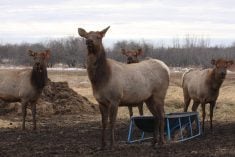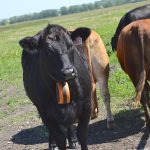RED DEER – Canada’s national cow herd decreased for the first time in three years but numbers may be adjusted once the Agriculture Canada census is completed this year.
“It was a bit of a surprise for some of us watching the data. It came in 1.5 percent lower,” said market analyst Anne Dunford of Canfax.
“We may see Statistics Canada go back and do a revision to the 2005 number, which was a little larger than we were expecting.”
In 2005, the national herd was reported at more than 15.1 million head, while the January 2006 report estimated 14.8 million.
Read Also

Why feds imposed EV tariffs
Moe and Kinew have a fight on their hands when it comes to eliminating the EV tariff. Canada has to worry about pissing off the U.S. and Mexico and hundreds of thousands of auto workers.
With no exports and low prices for older animals, Canadian producers were forced to retain animals while the United States expanded its herd because of improved prices.
Dunford told the annual Alberta beef industry conference held in Red Deer Feb. 18 that the Canadian beef cow herd remained at 5.28 million and changes across the West were slight.
Manitoba’s cow herd remained at 1.4 million. Saskatchewan dropped from three million head to 2.95 million. Alberta was almost unchanged at 5.9 million, while British Columbia dropped to 660,000 cows from 710,000 in the January 2005 count.
The cow slaughter numbers have improved but there is still no indication when the United States may reopen its market to animals older than 30 months. Before BSE closed borders, many cull animals went to U.S. slaughter plants.
Dunford said there would be trouble downsizing this herd unless the U.S. opens its borders to older animals.
Last year saw the largest cow kills since 1996, with nearly 17,000 per week going to market. This is a 34 percent increase over 2004.
The 2005 statistics indicated about 800,000 cows were removed, amounting to a 10 percent cow kill, which falls within the historic average.
With the cow kill and about five million calves available for feeding programs, Canadian beef production for 2005 yielded an eight percent increase in beef tonnage to 3.58 billion pounds of meat.
Steer carcass weights also were heavier in 2005 and added to the meat supply.
Renewed trade and more slaughter capacity saw the largest fed steer marketing in history at 2.27 million head, either slaughtered here or exported for slaughter.
Heifer marketings were also near record levels at 1.45 million.
With that mountain of beef available, exports are necessary.
Canadians consumed 2.2 billion lb. last year. Almost 85 percent of beef eaten at home is domestic product compared to about 50 percent in 2002.
Exports of beef and cattle are returning to previous levels.
Also on the increase is Canadian slaughter capacity. In 2005, 4.1 million head were killed here and 4.65 million are expected in 2006 if plants run full out. In 2007, if new plants open, nearly five million could be killed.
Weekly capacity in federal plants was 73,000 head per week in the pre-BSE period. Late 2004 grew to 84,000 and before the border opened last July, plants could handle about 88,000. Standing capacity is about 93,000 right now, but plants are typically running at 60 to 70 percent capacity.
Since last July when the border reopened, 213,000 feeders made their way south and Dunford forecasts 350,000 to 400,000 will leave in 2006.
Fed cattle exports to the U.S. have averaged around 15,000 per week.
“Fed cattle exports have ratcheted back up to where they were pre-BSE,” she said.
However, exporters must be mindful of falling U.S. prices, the impact of the 87 cent Canadian dollar and the wide basis levels.
“Be aware that we are in a lower return U.S. market,” Dunford said.
The U.S. market is volatile and the basis level on fed cattle has been a struggle. When the border opened, exporters looked at additional costs of about $2 per cwt to export. The average basis over the past seven months between cash to future is $10-$15, about $5 above the historic level.
Still, the U.S. remains an attractive market. Profitability is strong and producers have incentives to continue, but there is a major drought in the southern U.S. meaning cows and heifers might be removed from breeding.
“It could be bullish for the next few years,” said Duane Lenz of Cattlefax, who discussed the American market situation at the conference.
The U.S. prices probably peaked at the end of 2005 and will continue to decline for all classes for the next five years. However, prices will not dip as sharply as the last two cycles because of good beef demand.















